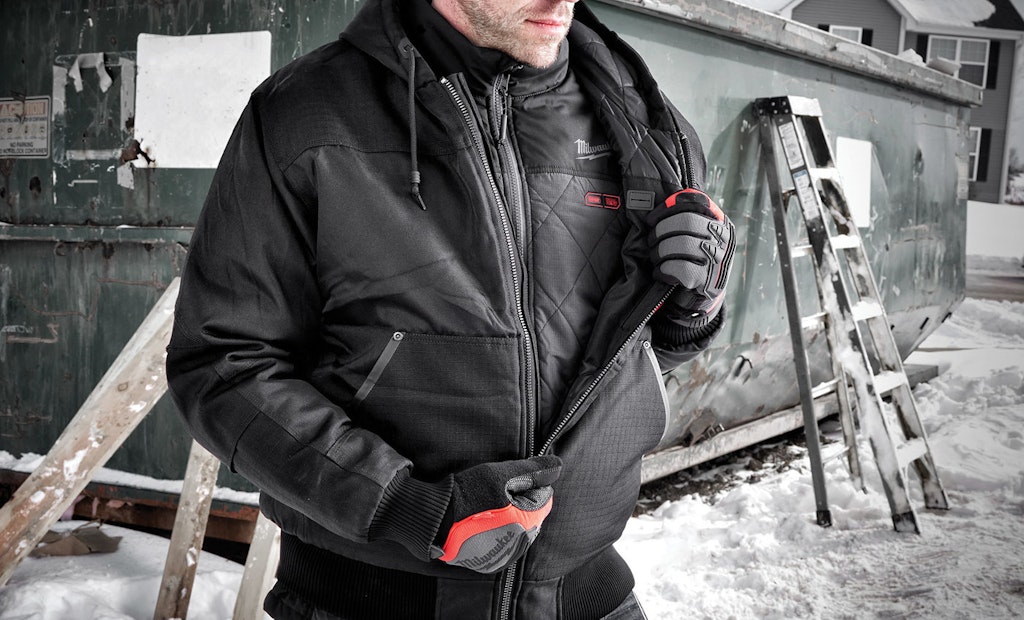
Milwaukee Tool’s cold-weather clothing is powered by M12 REDLITHIUM battery technology, using carbon fiber heating elements to create and distribute heat to the chest, back and front pockets. (Photo courtesy of Milwaukee Tool)
Interested in Safety?
Get Safety articles, news and videos right in your inbox! Sign up now.
Safety + Get AlertsFor many contractors in North America, working in the cold is a way of life. It’s not fun, but it’s something that needs to be done.
“For a better part of the year, we contend with the cold weather,” says Eric Aune, co-owner of Mechanical Hub and owner of Aune Plumbing in central Minnesota. “It’s about seven months of the year.”
Aune makes working in the cold a little more bearable for his workers by offering cold-weather gear to them. Not just regular jackets and gloves, but heated workwear from Milwaukee Tool, a Wisconsin manufacturer.
Bring the heat
Milwaukee Tool offers a series of jackets, hoodies and vests. Other manufacturers like DeWALT Tool and Ergodyne also offer heated jackets and hoodies.
“We started back in 2010 with a singular red, heated jacket, really not knowing what we were stumbling into,” says Kaue Cavalcante, product category manager for lifestyle products with Milwaukee Tool. “Since then, we’ve gone through many different generations of heating technology.”
The expansion of construction-grade heated clothing is an extrapolation from the broader market of civilian heated clothing, but the caliber of durability sets these products apart.
“If you look at heated gear in North America today, there are many, many competitors in this space,” Cavalcante says. “I think the appreciation for how durable and well-built these garments are — that’s really what appeals to our audience doing work on job sites.”
Milwaukee Tool’s clothing is powered by M12 REDLITHIUM battery technology, using carbon fiber heating elements to create and distribute heat to the chest, back and front pockets. This year, the manufacturer also added a new Quick-Heat function that helps deliver heat faster than before, fully heating up the jacket in 2.5 minutes.
Cavalcante notes that company officials are constantly going on research trips all over the country in order to understand what customers need and what users are currently frustrated with.
Durable gear
Aune’s favorite piece of heated clothing is the hoodie, for its flexibility. The hoodie has a waffle-weave thermal lining to help keep the heat in.
“The sweatshirts take probably the biggest beating because they’ll be worn in the fall and the spring, and then also through the winter,” Aune says. “I wear my sweatshirt as a coat probably three-quarters of the time, so I’d say that they take a lot more abuse than I would have imagined. You’ve got these heating elements inside, and you think that it’s not something that’s going to be able to take abuse but I would say that’s not true at all.”
The heated gear can be washed like normal clothes after removing the battery, which has its own pocket and simple hookup. After about three years, the equipment Aune bought for his team is still holding up, despite consistent day-to-day use, though he’s considering purchasing a new set for his guys.
“They’ve got a three-in-one style,” Aune says. “It’s about double the cost, but it’ll be worth it because you’ve got a sweatshirt, vest and outer parka-style coat, which is probably more suitable for a wider range of temperatures.”
The jackets and vests are equipped with reinforced high-wear zones to protect from abrasion and tears, feature polyester insulation that keeps heat in but doesn’t add bulk, and are wind- and water-resistant.
Safe and productive
Heated gear isn’t cheap, with a price tag often at least double that of similar nonheated garments. For example, the heated hoodie is around $100 and the jacket is about $150 from most dealers. They say you can’t put a price on comfort, and Aune says for contractors who deal with cold, that holds true.
“It brings higher productivity,” Aune says. “We will find ourselves on job sites where there’s no heat — there’s no break from the elements — and one of the hardest things to get over is just your body feeling cold. A lot of what we do can be done in those cold temperatures; the materials we’re using will allow for it, but the limitations are comfort. If we can be more comfortable, then we can produce more through the day.”
Aune adds that it’s about safety as well, feeling more confident with some of his workers who may not want to take a break to warm up.
“If I can keep them warmer, then I feel like they’re going to be more safe,” Aune says. “They’re not going to make mistakes that might cause personal harm.”
This year, Milwaukee Tool made its first foray into heated accessories with a heated work glove complement to its line of gear, and officials say there’s more ahead for this segment of the industry.
“We’re not going to slow down in this category at all,” Cavalcante says. “If anything, you’re going to see a ton more solutions and innovation in the years to come.”





